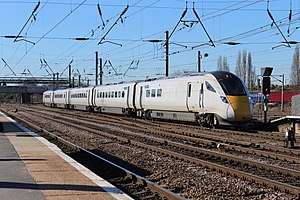British Rail Class 801
| British Rail Class 801 Super Express | |
|---|---|
 801101 on test at Doncaster, April 2018 | |
| In service | 2018 (planned)[1] |
| Manufacturer | Hitachi |
| Built at |
|
| Family name | A-Train |
| Replaced | |
| Constructed | 2017 - present |
| Number built |
30 x 9-car sets 12 x 5-car sets |
| Operator(s) | London North Eastern Railway |
| Line(s) served | East Coast Main Line |
| Specifications | |
| Car body construction | Aluminium |
| Car length | 26 m (85 ft 3 5⁄8 in) |
| Maximum speed |
|
| Weight | 41 tonnes per coach[2] |
| Electric system(s) | 25 kV 50 Hz AC overhead lines |
| Current collection method | Pantograph |
| Safety system(s) | AWS, TPWS, ETCS, ATP |
| Track gauge | 1,435 mm (4 ft 8 1⁄2 in) standard gauge |
The Class 801 Super Express is the electric multiple unit (EMU) variant of the Hitachi Super Express, based on the Hitachi A-train, high-speed trains to be used in the United Kingdom. They are being built by Hitachi from 2017 at Hitachi's purpose built facility at Newton Aycliffe, alongside the related electro-diesel Class 800.[3]
Background and design
As part of the UK Government's Intercity Express Programme, the Class 801 units were to be replacements for the InterCity 125 and InterCity 225 trains which currently operate services on the Great Western Main Line (GWML) and the East Coast Main Line (ECML).[4] The Class 801 units were designed as electric multiple units. However, owing to delays in the electrification of the GWML, in June 2016 the Government announced that the 21 units planned for use by Great Western Railway would instead be converted to bi-mode operation,[5] and they were later reclassified as Class 800/3.[6] As a consequence, Class 801 units will be used exclusively on the ECML.
Fleet details
| Class | Operator | No. Built | Year Built | Cars per Set | Unit nos. |
|---|---|---|---|---|---|
| Class 801/1[7] | London North Eastern Railway | 12 | 2017- | 5 | 801101–112 |
| Class 801/2[7] | 30 | 2017- | 9 | 801201–230 | |
Auxiliary power
The Class 801 is not regarded as an electro-diesel but it does have one diesel-powered generator unit (GU) per set. This can be used to move the train to the next station, at reduced speed, if the electricity supply from the overhead line fails.[8]
Interiors
The new interiors have received praise for the increased leg-room and greater number of tables in Standard Class, compared to the Intercity 125 trains which are to be replaced. They have received criticism for a lower level of comfort for First Class passengers compared to the Intercity 125 trains, and the lack of a buffet counter or restaurant car.[9]
See also
References
- ↑ https://www.railmagazine.com/news/fleet/iep-use-to-be-decided-by-operators
- ↑ http://data.parliament.uk/writtenevidence/committeeevidence.svc/evidencedocument/welsh-affairs-committee/the-cancellation-of-rail-electrification-in-south-wales/written/73604.html
- ↑ Government gives green light for more state-of-the-art intercity trains, Department for Transport, 18 July 2013
- ↑ DfT Confirms Second Intercity Trains, Railnews, 18 July 2013
- ↑ Hitachi converts GWR ‘801s’ to bi-mode operation, Rail Magazine, 8 June 2016
- ↑ "Great Western bi-mode '801s' to be reclassified as Class '800/3s'". Rail. Peterborough: Bauer Media. 20 July 2016. p. 33.
- 1 2 "EMU Formations". AbRail. AbRail. Retrieved 18 November 2015.
- ↑ http://www.ieptrain.co.uk/technical-configuration/
- ↑ https://www.railmagazine.com/news/rail-features/does-great-western-railway-s-class-800-iet-pass-the-test
External links